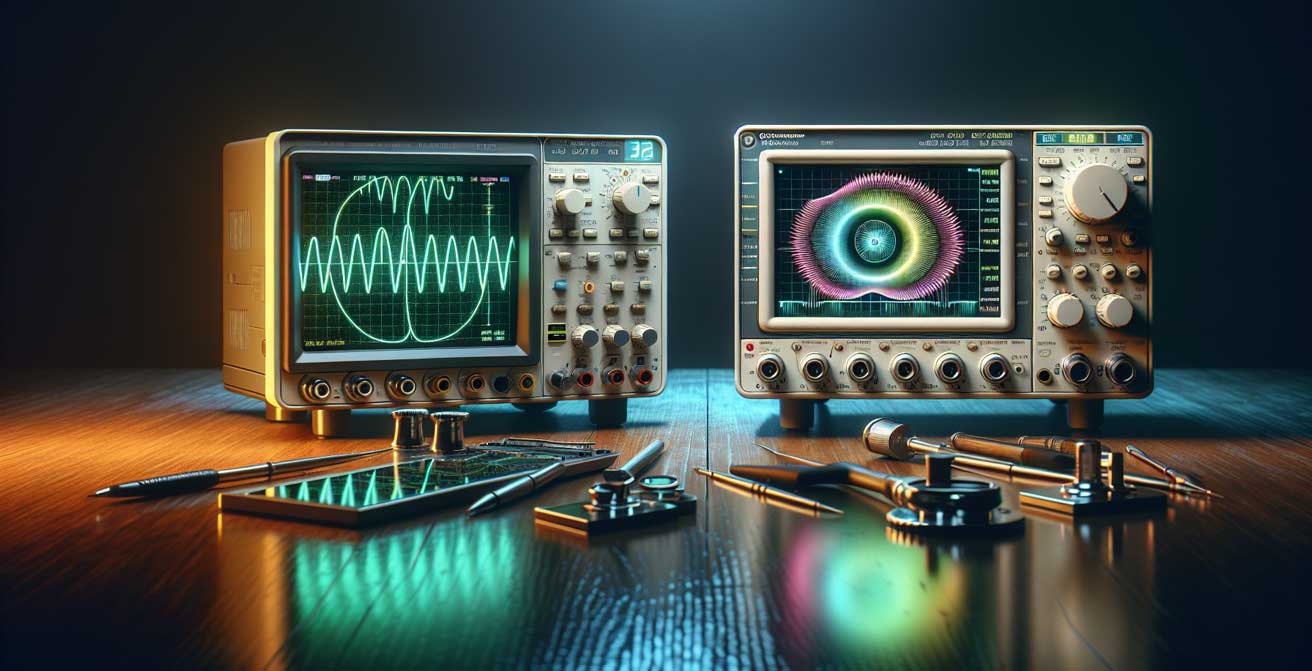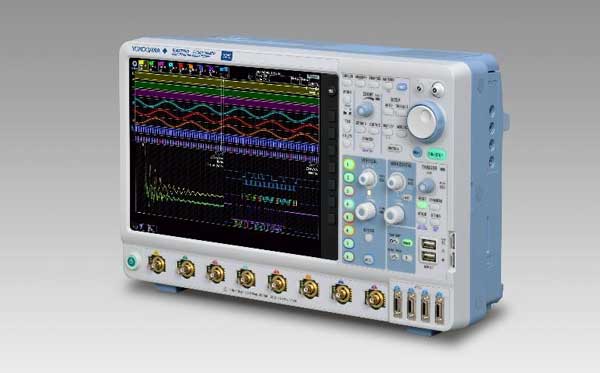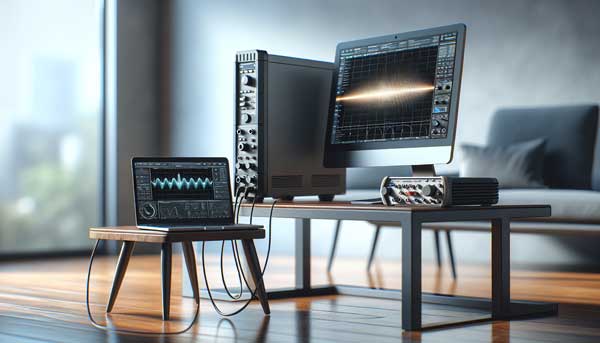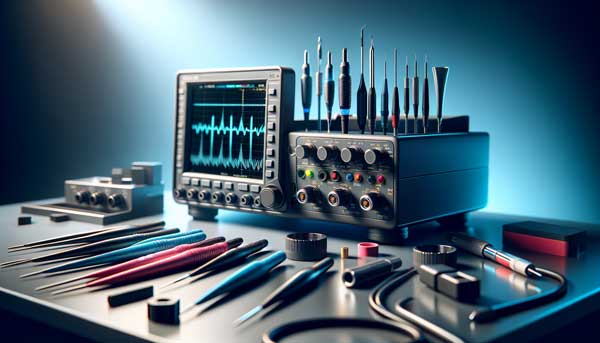Oscilloscope | Guide to Effective Measurements
- Details
- Hits: 897
which oscilloscope fits my work? Digital oscilloscopes offer advanced analysis capabilities, while analog oscilloscopes remain irreplaceable for certain applications. Find out here what an oscilloscope can do and how to choose the right model for your needs Measurement tasks find and which ones New Products there is on the market.

Contents
- Oscilloscopes 2024 – The most important things at a glance
- Oscilloscope innovations 2024
- Digital and Analog Oscilloscopes: A Comparison
- Handheld Oscilloscopes: Portability and Versatility
- Mixed-Signal Oscilloscopes: The best solution for complex signals
- PC Oscilloscopes: Flexibility and Compatibility
- Key Features When Choosing an Oscilloscope
- Accessories and probes for oscilloscopes
- Practical tips for using oscilloscopes
- Frequently asked questions
Oscilloscopes 2024 – The most important things at a glance
- Digital Oscilloscopes have largely replaced analog models due to their compact design, energy efficiency and advanced analysis functions.
- Handheld-Oscilloscopes with multimeter functionality offer flexibility and mobility for field service applications, with some models also functioning as full true RMS multimeters.
- Mixed signal-Oscilloscopes are ideal for simultaneous analysis of analog and digital signals, especially for troubleshooting digital circuits.
Oscilloscope innovations 2024
Whether you need an analog, digital, handheld, PC or mixed-signal oscilloscope depends on your specific needs and applications. Below we will introduce you to the new products.
Next generation oscilloscopes
 16.02.2024 | Rohde & Schwarz expands its oscilloscope range with the innovative R&S MXO 5, the company's first eight-channel oscilloscope. This leading-edge device sets new standards in signal analysis by being based on the powerful MXO-EP processing ASIC technology. It offers unmatched measurement performance, enabling design engineers to meet even more demanding design requirements and debug their projects more efficiently.
16.02.2024 | Rohde & Schwarz expands its oscilloscope range with the innovative R&S MXO 5, the company's first eight-channel oscilloscope. This leading-edge device sets new standards in signal analysis by being based on the powerful MXO-EP processing ASIC technology. It offers unmatched measurement performance, enabling design engineers to meet even more demanding design requirements and debug their projects more efficiently.
The R&S MXO5 Redefines the precision in signal tracking via its eight channels with up to 4,5 million acquisitions per second and more than 18 million measurement curves per second. This performance is critical for capturing fine signal details and rare events, making the devices particularly suitable for demanding applications in areas such as power conversion and automotive.
45.000 FFTs/s performance
The exceptional FFT performance with 45.000 FFTs per second enables excellent representation of signals in the frequency domain, making the oscilloscope ideal for EMI and harmonic tests. The world's highest acquisition rate allows the oscilloscope to record up to 99% of real-time signal activity to register, which significantly speeds up signal analysis.
With an industry-leading storage offering of 500 Mpts in standard configuration and optional expansion to up to 1 Gpts The R&S MXO 5 offers enough capacity to record large amounts of data and to capture longer periods of time without loss of bandwidth data accuracy.
The device sets new standards as the first eight-channel oscilloscope with digital triggering and enables precise isolation of small signal anomalies thanks to its high sensitivity and the 18-bit architecture. These capabilities make it an ideal tool for power and signal integrity measurements as well as logic and bus protocol testing.
Intuitive operation via a 15,6" Full HDTouchscreen, combined with a compact design and the lowest volume in its class, ensures an optimal user experience.
High-resolution mixed-signal oscilloscope
 15.02.2024/5000/XNUMX | The DLMXNUMXHD oscilloscope series expands the product portfolio Yokogawa related to the vertical resolution. With the new 12-bit A/D converter technology and a lower noise floor, the new oscilloscope impresses when it comes to signal analysis, especially with different input voltages. The HD version also offers improved functions that make it easier to use in everyday measurement.
15.02.2024/5000/XNUMX | The DLMXNUMXHD oscilloscope series expands the product portfolio Yokogawa related to the vertical resolution. With the new 12-bit A/D converter technology and a lower noise floor, the new oscilloscope impresses when it comes to signal analysis, especially with different input voltages. The HD version also offers improved functions that make it easier to use in everyday measurement.
The oscilloscopes DLM5000HD series is available as a 4- or 8-channel version with bandwidths of 350 and 500 MHz. A newly designed 12-bit A/D converter ensures high vertical resolution and improved signal representation and analysis, e.g. B. in the development of power electronics. The vertical resolution of 12-bit is available without restrictions on the sampling rate or number of channels. When high-resolution mode is activated, up to 16-bit resolution can be achieved.
Also expands the HD variant offering the existing DLM5000, which provides 8-bit vertical resolution. The DLM5000HD offers an optimized low noise floor, extensive voltage ranges and many real-time low-pass filters per channel, ensuring high signal fidelity.
Synchronization expands channel number
If there is a need for more than 8 analog channels The DLM sync function allows the synchronization of two oscilloscopes. The clock and trigger synchronization of both devices takes place via just one special cable. This expands the number of channels to up to 16 analog (8 + 8) and 64 digital channels. Alternatively, a mixed configuration of 4- and 8-channel models can be implemented.
The memory offers signal capture up to one gigaword. He also benefits from this History memory. With this function, up to 200.000 previously recorded measurements are automatically stored. The signals can be displayed individually, overlaid or in a list with a time stamp.
Regarding the serial bus analysis, the intelligent Auto Setup Function further optimized. The automatic detection of the bit rate and trigger threshold can be used for stored and mathematically processed measurement data. This extends the auto setup function, which previously could only be used for existing signals.
Applications for the new oscilloscopes can be found in electronics for automotive and transport as well as in control devices, drives and serial bus systems, in power electronics, in household appliances, air conditioning and fans as well as in industrial plants.
Digital and Analog Oscilloscopes: A Comparison
Oscilloscopes come in various shapes and styles, but the two most basic types are digital and analog oscilloscopes. Digital oscilloscopes use this LCD technology for larger and colored displays, while analog oscilloscopes cathode ray tubes based. The more compact design and higher energy efficiency of digital oscilloscopes offer advantages over larger and more energy-intensive analog models. In addition, modern digital oscilloscopes offer advanced features such as pre-triggering, analysis software, averaging and mathematical functions that enable more detailed signal analysis.
On the other hand, analog oscilloscopes store the signal image directly on the tube, while digital devices store the signal digitally, allowing subsequent processing and detailed analysis. Nowadays, technological advantages and advanced features have resulted in digital oscilloscopes largely replacing analog models in the market.
Digital oscilloscopes
Digital oscilloscopes are used to display the electrical voltage over time and allow Voltage measurements as a function of time as well as time and frequency measurements. They are particularly suitable for recording, storing and analyzing high-frequency signals.
In the vertical system of a digital oscilloscope, the input signal is represented as a function of time, while the horizontal system allows the wave pattern to be visualized over the time scale. This allows users to dynamics understand signal changes over time and check signal integrity.
Modern digital oscilloscopes offer display and measurement functions such as:
- Zoom
- Peak measurements
- Recording of rise and fall times
- More precise representation of measurement data thanks to fast processors.
These features expand the possibilities of signal analysis and make digital oscilloscopes an indispensable tool for engineers and technicians.
Analog oscilloscopes
In contrast to digital oscilloscopes, analog oscilloscopes allow you to physical quantities, which can be depicted as an electrical voltage over time. They usually use BNC sockets to connect input voltages. They are particularly advantageous for detecting periodic signals and displaying characteristic details, for example in sound engineering.
In addition to the normal waveform display, analog oscilloscopes can also be used to display XY displays, such as Lissajous figures, will be realized. They typically have an input impedance of 1 MΩ and an input capacitance of 20 to 50 pF. This makes them ideal for studying signal interactions and phase relationships along the X axis and Y axis.
The typical areas of application for analog oscilloscopes range from measuring DC voltages to high-frequency signals in devices such as radios, televisions or computers. Although digital oscilloscopes are becoming increasingly popular due to their advanced features, analog oscilloscopes still have their place in certain applications.
Handheld Oscilloscopes: Portability and Versatility

Handheld oscilloscopes are ideal for testing and due to their compactness and portability Field service applications. Their compact design makes them ideal for applications where space and mobility play a role. These devices allow measuring voltage, frequency, recording transients and performing mathematical functions such as Fourier spectral analysis. They are typically designed as digital sampling oscilloscopes with a compact display.
The advantages of handheld oscilloscopes include their mobility, operation via battery or power supply and, in some models, the integration of digital multimeter functionality.
Multimeter function
Handheld oscilloscopes with multimeter function can be used as full-fledged ones True RMS multimeter can be used that can measure voltage, current, resistance, capacity, continuity and diodes, such as the Owon HDS272S. This extends their functionality beyond that of a traditional oscilloscope and allows users to perform a variety of measurements with a single device.
They offer an automatic measuring range and show measured values large on an integrated display. The Owon HDS272S, for example, has a high-contrast 3,5 inch color display for outdoor use. This makes it an ideal choice for technicians and engineers who often work outdoors or travel.
Mixed-Signal Oscilloscopes: The best solution for complex signals
Mixed-signal oscilloscopes (MSOs) make this possible simultaneous analysis of analog and digital signals. They are particularly suitable for verifying and troubleshooting digital circuits. They offer the flexibility to acquire digital signals in both timing and state acquisition modes.
To simplify analysis, MSOs can display digital timing waveforms color-coded, with logic lows typically shown in blue and logic highs in green.
Fields of application
MSOs allow you to find and analyze crosstalk between digital signals by displaying digital and analog simultaneously waveforms. This enables in-depth analysis of signal interference and improves the ability to troubleshoot and optimize circuits.
MSOs are also used to troubleshoot serial protocols such as RS232 and I2C, which is particularly beneficial when working with microcontrollers. They can be used to Analog-to-digital converter (ADCs) to check for missing codes and to ensure the correct function of the signal processing system. This makes them an indispensable tool in numerous applications.
PC Oscilloscopes: Flexibility and Compatibility
 PC oscilloscopes with USB port are:
PC oscilloscopes with USB port are:
- small, light and handy, which makes them particularly compatible and flexible,
- can both desktopcomputer as well Laptops be connected,
- can flexible be used in different environments and situations,
- allow one detailed and large display of the measurement curves on the PC screen, which is advantageous for analysis and evaluation.
PC oscilloscopes are popular due to their increased performance, portable applications and the option to cableto solve Communication with mobile devices via apps is advantageous.
Benefits and Applications
PC oscilloscopes offer the following Benefits:
- Height Exactlyity,
- Instante data processing,
- Many Kanäle for measurements,
- Unlimitede Amount of data due to the size of the PC's hard drive.
You can comfortably from your desk can be used and enable you to carry out complex analyzes and measurements.
Extensive software functions enable precise control of triggers, channel settings and other functions for improved evaluation and display of measurement data. The measurement data can be used for the Teamwork Easily stored and shared, and regular free software updates expand the device's capabilities using the same hardware.
Spectrum analyzers as accessories for PC oscilloscopes are used to examine the frequency composition of signals. This enables a wide range of applications.
Key Features When Choosing an Oscilloscope
When choosing an oscilloscope, consider the following Features decisive:
- bandwidth: determines the frequency at which signals are still transmitted correctly and should be well above the frequency of the signal to be measured,
- sampling rate: must be high enough to accurately digitize the signal according to the Nyquist theorem and avoid aliasing,
- Resolution: determines the accuracy of the measured values and should be sufficiently high to be able to recognize fine details in the signal,
- amount of channels: determines how many signals can be measured at the same time.
These performance characteristics should be considered when selecting an oscilloscope. The resolution of the oscilloscope is determined by the Bit rate of the ADC determined and is crucial for the accuracy when displaying small signals. With a 12-bit resolution, the signals can be displayed even more precisely. The number of channels affects how many signals can be tracked simultaneously. It should be chosen based on the specific requirements of the application.
Accessories and probes for oscilloscopes
 Probes are essential accessories for oscilloscopes that are used to adapt and transmit measurement signals. Passive low voltage probes are the most commonly used form. Special probes such as current clamps, active and differential probes as well as high-voltage probes enable the measurement of special types of signals and voltage ranges. For accurate measurement results, the bandwidth and capacitance of the probe must match the specifications of the oscilloscope.
Probes are essential accessories for oscilloscopes that are used to adapt and transmit measurement signals. Passive low voltage probes are the most commonly used form. Special probes such as current clamps, active and differential probes as well as high-voltage probes enable the measurement of special types of signals and voltage ranges. For accurate measurement results, the bandwidth and capacitance of the probe must match the specifications of the oscilloscope.
The oscilloscope, one of the most important measuring devices, can be equipped with additional accessories such as ground clamps and flexible adapters be equipped to expand measuring capabilities and simplify everyday handling. When using probes, safety guidelines such as observing the maximum allowable voltage and proper grounding should be followed to ensure user safety.
Practical tips for using oscilloscopes
Before using an oscilloscope for the first time, you should connect the device to the internal Calibration signal compare. To do this, the probes are connected to the calibration port of the oscilloscope before the measurements begin. This ensures that the voltage and frequency of a signal are displayed correctly. The correct division ratio on the oscilloscope and probe is crucial so that the displayed signal size corresponds to the actual voltage, which is adjusted via switches and menu buttons. The measuring terminal and ground terminal of the probe must be correctly connected to the measuring point or to the ground of the circuit in order to obtain exact measured values.
After connecting the probe, the scaling of the oscilloscope must be adjusted in order to be able to clearly read the voltage in relation to the vertical division. For the complete representation of a periodic signal the horizontal time scale can be set so that multiple periods are visible. Vertical scaling must show the highest and lowest points of the signal. Adequate sensitivity and time scale are important to optimally represent the signal on the display for precise analysis. The trigger function of the oscilloscope is used to create a static image of the signal by appropriately setting the trigger level, mode and criterion. If anything is unclear or there are problems with the display of the signal, connections, settings and external sources of interference should be checked as part of the troubleshooting process.
The use of Auto range function can make adjusting vertical scaling and time base easier, but manual adjustments may be necessary for optimal results. The oscilloscope's integrated functions, such as saving measurements as an image or CSV, automatic measurements and mathematical functions, should be used to evaluate and document the results.
Frequently asked questions
What is an oscilloscope simply explained?
An oscilloscope is a device that makes the temporal progression of electrical voltage signals visible by exploiting the almost inertia-free deflection of the electrons in the electric field. Along with the multimeter, it is one of the most important measuring and diagnostic devices.
What do you need an oscilloscope for?
An oscilloscope is needed to measure the time Course of electrical voltages graphically display and directly measure electrical quantities such as voltage, time, frequency, phase and amplitude. Therefore, it is an indispensable instrument in electronic measurement technology.
What does an oscillograph do?
An oscillograph is used for graphical representation electrical voltages and enables a variety of adjustments to the time display. The cathode ray tube is the most important component of an oscillograph for displaying changing voltages.
Source: This article is based on information from the following companies: Rhode+Schwarz, Yokogawa.

Jens Struck is a business owner, journalist and web designer at German Online Publisher GbR in Ried.
